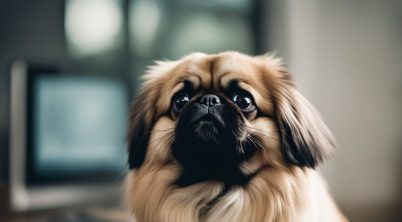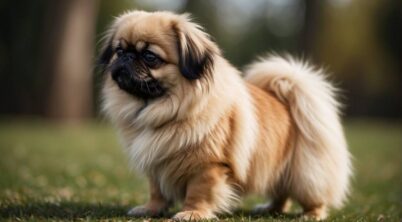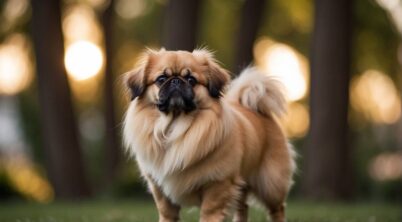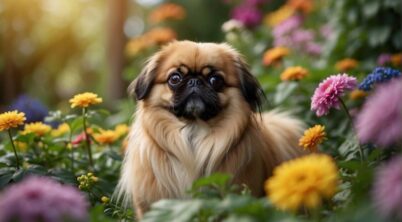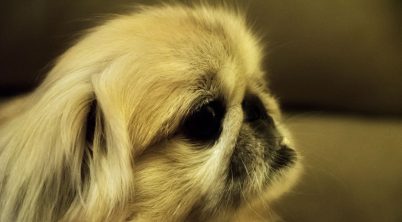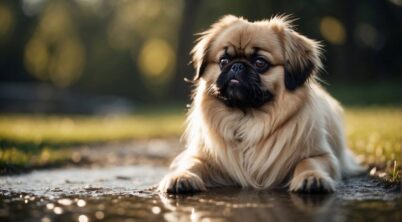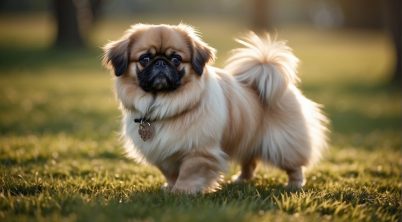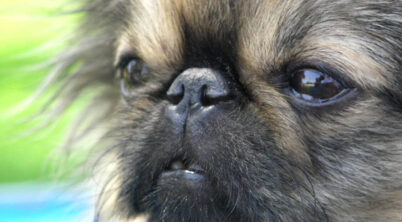The Pekingese, a toy dog breed with a distinctive lion-like mane and a rich history rooted in ancient China, typically boasts a luxurious double coat that requires regular grooming. This breed’s coat is one of its defining features, characterized by thick underfur and a long outer coat. Maintaining the health and appearance of this coat is a significant aspect of Pekingese care. However, a Pekingese with no hair presents a unique situation that deviates from the norm and prompts a different approach to grooming and care.
A Pekingese without hair could be the result of a variety of circumstances, ranging from medical conditions such as alopecia, which can cause hair loss, to deliberate grooming choices where the coat is closely trimmed or shaved. Whatever the reason for their hairlessness, these Pekingese require special attention to their skin to compensate for the lack of natural protection provided by their coat. The absence of hair alters the traditional grooming practices associated with the breed and emphasizes the need for skin care to prevent issues like sunburn or irritation.
When encountering a Pekingese with little to no hair, owners must adapt their care routine to address the dog’s changed needs. This includes finding suitable ways to keep the dog warm without their natural insulating layer, being vigilant about skin health, and understanding the implications of hairlessness on the dog’s overall wellbeing. It’s important to consult with a veterinarian to identify the cause of hair loss and to ensure the appropriate measures are taken to maintain the dog’s health and comfort.
Understanding Pekingese Coat Characteristics
The Pekingese is distinguished by its thick and fluffy coat, which requires regular maintenance. They have a double coat, with the undercoat being softer and the outer coat more coarse and straight.
Distinguishing Coat Types
The Pekingese dog breed is well-known for its double coat. Their unique coat features two distinct layers. The outer layer is long, coarse, and straight, serving as protection. Underneath lies a soft, fluffy undercoat that provides insulation. This coat can appear in a range of colors and patterns, and it is particularly thick around the neck and shoulders, giving the Pekingese a regal mane.
Shedding and Undercoat
Pekingese dogs shed throughout the year, with seasonal peaks typically during spring and fall when they shed their undercoat. The shedding can be significant, so regular grooming is crucial to manage loose hair and maintain the coat’s condition. Their undercoat is dense, which can lead to matting if not properly brushed. Regular, thorough brushing helps remove the dead undercoat and reduce shedding.
Essentials of Pekingese Grooming
Pekingese dogs are distinctive for their luxurious coats that require attentive grooming. Proper maintenance is crucial for their well-being and appearance.
Routine Brushing Techniques
To maintain a Pekingese’s coat, daily brushing is imperative to prevent mats and tangles. Owners should utilize a slicker brush to effectively remove loose hair and smooth out knots. Brushing not only keeps the coat healthy but also distributes natural skin oils throughout the fur, which promotes a glossy sheen. Here are the steps to follow:
- Gently brush the coat in the direction of the hair growth to avoid discomfort.
- Pay special attention to areas prone to matting, like behind the ears and beneath the legs.
- Use a comb for the finishing touches, ensuring no small tangles are left behind.
Importance of Regular Bathing
Regular bathing is essential for a Pekingese, but it’s important to remember that frequency should be moderate—typically every three to four weeks—to avoid drying out their skin. Here is a concise guide to bathing practices:
- Preparation: Ensure any mats are brushed out prior to bathing, as water can tighten them.
- Shampoo: Use a dog-specific shampoo that caters to their coat type. It should be gentle to not strip away essential oils, and it’s important to rinse thoroughly to prevent any residue that might cause skin irritation.
- Drying: Post-bath, Pekingese should be dried thoroughly but gently to avoid damaging their coat. A blow dryer on a cool setting is often recommended to expedite the process.
By integrating routine brushing and regular bathing into their care schedule, owners can preserve the health and beauty of their Pekingese’s coat.
Haircuts and Trimming for Pekingese
Selecting the appropriate haircut and performing precise trimming are crucial components in the grooming process of a Pekingese to maintain their regal appearance and hygiene.
Deciding on the Right Haircut
One must consider the Pekingese’s lifestyle and maintenance when choosing a haircut. The lion cut is popular, wherein the body hair is clipped short, leaving the face, legs, and tail tip longer resembling a lion’s mane. Another favored style is the puppy cut, which involves trimming the Pekingese’s coat evenly all over, making it more manageable and cooler for the dog.
- Lion Cut: Maintains longer fur around the head, ears, tail, and feet.
- Puppy Cut: Offers an even, short coat length for ease.
Professional Groomer Services
To ensure the best results, it’s advisable to seek a professional groomer who is experienced in Pekingese grooming. These professionals come equipped with the proper tools, like rounded-tip scissors for safe trimming around sensitive areas.
- Full Grooming: It includes a thorough bath, haircut to the owner’s preference, paw and ear cleaning, and nail trimming.
- Trimming: Focuses on cutting excess fur around eyes, paws, and ears to prevent discomfort and maintain visibility.
Regular grooming by a professional ensures that the Pekingese remains tidy, with haircuts and trimming done to breed-standard or owner preference while preserving the coat’s health.
Preventing and Managing Matting Issues
Matting in Pekingese dogs can be a significant concern due to their long, thick fur. It requires consistent attention to prevent discomfort and potential skin problems. Regular grooming is the key defense against matting and the development of tangles.
Techniques for Detangling
Detangling a Pekingese’s coat should be done gently to avoid causing discomfort. Here are specific techniques for effective detangling:
- Start with a Wide-toothed Comb: Begin with a wide-toothed comb to carefully work through minor tangles. Always comb in the direction of hair growth to prevent pulling, which can cause pain.
- Use of Detangling Sprays: Applying detangling sprays can provide lubrication, making it easier to separate mats without causing stress to the skin.
Tools for Tackling Mats and Tangles
Selecting the right tools is essential for managing a Pekingese’s coat. The following tools should be used:
- Slicker Brush: Ideal for daily brushing to smooth the fur and prevent the formation of new tangles.Use FrequencyBenefitDaily UseReduces likelihood of mat formation
- Mat Splitter: For severe mats, a mat splitter can carefully cut through the tangle without harming the skin.
- Technique: Insert the mat splitter at the base of the mat and slowly work upwards, slicing through the mat while holding the fur at the roots to avoid pulling skin.
Using these strategies and tools consistently will help maintain the Pekingese’s coat and prevent the painful issues associated with matting.
Targeted Care for Specific Areas
Caring for a Pekingese’s specific areas such as the face, ears, and paws demands special attention due to their unique structure and needs. Proper regular maintenance using appropriate tools can prevent health issues and keep them in comfort.
Facial Grooming and Eye Care
The Pekingese’s face requires careful and frequent grooming, focusing on the area around the eyes to prevent irritation and infection. Owners should use a damp cloth to wipe away any debris or build-up. In particular, the hair around the eyes should be kept short to avoid corneal scratches, and one should always be vigilant for signs of weeping or redness that could indicate an underlying issue.
Ear Cleaning Practices
Regular ear cleaning is a critical aspect of a Pekingese’s care routine to prevent ear infections. An ideal approach involves using a vet-approved ear cleaner and gently wiping the outer ear flap and the entrance of the ear canal. It’s important to never insert anything deep into the ear canal to avoid damage. For the ear cleaning process, the following tools are recommended:
- Cotton balls or pads
- Vet-approved ear cleaner
- Tweezers (for removing larger debris)
Owners should check their Pekingese’s ears frequently for wax buildup, foul odor, or any sign of distress that might suggest an ear issue.
Paw and Nail Care
Paw and nail care are paramount to prevent discomfort and mobility issues in Pekingese.
- Nails: Regular trimming with nail clippers or a grinder prevents overgrowth that can lead to discomfort or even injury. One should be cautious to avoid cutting the quick, which can cause pain and bleeding.
- Paw Pads: The pads of the feet should be inspected often for any signs of injury or foreign objects lodged within. During grooming, checking the paw pads helps to ensure they are not cracked or dry. Moisturizing balms specifically designed for dogs can be used if needed.
Understanding Pekingese Skin and Coat Health
The health of a Pekingese’s skin and coat directly correlates with their overall well-being. Owners should be vigilant in recognizing signs of skin irritation and ensure proper grooming to maintain healthy skin.
Addressing Skin Irritations
Skin irritations in Pekingese can manifest as itching, scratching, or inflammation, often signaling underlying issues like allergies, infections, or parasites. To approach such concerns:
- Allergies: They can be dietary or environmental; identify triggers with the help of a veterinarian.
- Infections: Fungal or bacterial infections must be diagnosed and treated with appropriate medication.
- Parasites: Prompt treatment for infestations such as fleas or mites is imperative.
Consistent evaluation by a veterinarian ensures that irritations are not signs of more serious health issues. The application of prescribed treatments can alleviate discomfort and prevent further complications.
Maintaining a Healthy Skin and Coat
A Pekingese requires regular grooming to retain the health of their skin and coat:
- Grooming Regimen: Gentle cleaning of dirt, especially around sensitive areas like the eyes and face, should be done daily.
- Bathing: Use conditioner to replenish natural oils and prevent over-drying of the skin.
- Brushing: Regular brushing distributes natural oils, removes dead hair, and prevents matting.
Effective grooming practices contribute to a shiny, mat-free coat and healthy skin, reducing the risk of complications from overgrowth and debris entrapment.
Grooming as Part of Pekingese Lifestyle
Grooming is more than a beauty routine for a Pekingese; it is crucial for their health and well-being. Effective grooming incorporates consistent schedules, rewards, and behavioral strategies to ensure a positive experience for the dog.
Integrating Grooming into Daily Routines
Consistency is key when incorporating grooming into a Pekingese’s daily lifestyle. Adhering to a regular schedule not only maintains the Pekingese’s coat in optimal condition, preventing mats and tangles, but it also helps the dog to understand and expect the process as part of its day-to-day activities. Here are a few steps owners can take:
- Daily Brushing: This should be a non-negotiable part of the routine, ideally at the same time each day.
- Weekly Bathing: Using the right canine shampoos and careful rinsing, bathing can keep the skin and coat healthy without drying out.
- Regular Trimming: Especially around eyes, ears, and paws, this keeps the Pekingese comfortable and tidy.
Most importantly, each grooming session should be approached with patience, allowing the Pekingese to gradually acclimate to the process over time.
Overcoming Grooming Challenges with Behavioral Techniques
Behavioral techniques play a significant role in overcoming the challenges that might arise during the grooming of a Pekingese. These techniques involve:
- Using Treats: Small rewards during and after the grooming session can encourage cooperation and create a positive experience.
- Offering Praise: Verbal affirmations serve as positive reinforcement, helping to raise the Pekingese’s self-esteem in regards to grooming.
- Gentle Pets: Physical affection reinforces good behavior and soothes the dog, establishing trust and a bond during grooming sessions.
By combining treats, praise, and pets, grooming becomes a comfortable and enjoyable activity, reinforcing positive behaviors and easing the grooming process for both the Pekingese and the owner.
Pekingese Grooming for Health and Presentation
Proper grooming of a Pekingese is essential not only for maintaining its distinctive appearance but also for ensuring the dog’s overall health, including dental hygiene. It is a critical aspect for show dogs that are evaluated based on standards set by organizations such as the American Kennel Club.
Health Considerations Influencing Grooming
Dental Hygiene: Pekingese can face health problems if their dental hygiene isn’t managed regularly. Dog owners should incorporate the use of canine-formulated toothpaste and a soft-bristled toothbrush into their routine to prevent plaque buildup and tooth decay.
- Dental checks during grooming should be standard.
- Choose high-quality toothpaste designed specifically for canines.
Overall Health: Regular grooming allows breeders and owners to check for signs of skin irritations or infections that might otherwise go unnoticed beneath the Pekingese’s thick coat.
- Look for redness, rashes, or signs of discomfort during grooming sessions.
- Maintain a schedule to monitor health consistently.
Preparing for Dog Shows
The American Kennel Club Standards: Pekingese show dogs must adhere to specific grooming standards set by the American Kennel Club, where presentation is a reflection of the dog’s care and breeding quality.
- Accurate and breed-specific trimming around the face, ears, and paw areas.
- Consistent grooming routines are necessary for show-readiness.
Professional Grooming for Shows: Breeders often rely on professional groomers to prepare a Pekingese for dog shows, ensuring the coat is trimmed and styled without jeopardizing the dog’s comfort and the breed’s characteristic appearance.
- Invest in a reputable groomer experienced with Pekingese and show requirements.
- A well-groomed coat is both visually appealing and indicative of the dog’s health.
* Banner photo by Subin LEE, cropped | Some rights reserved

